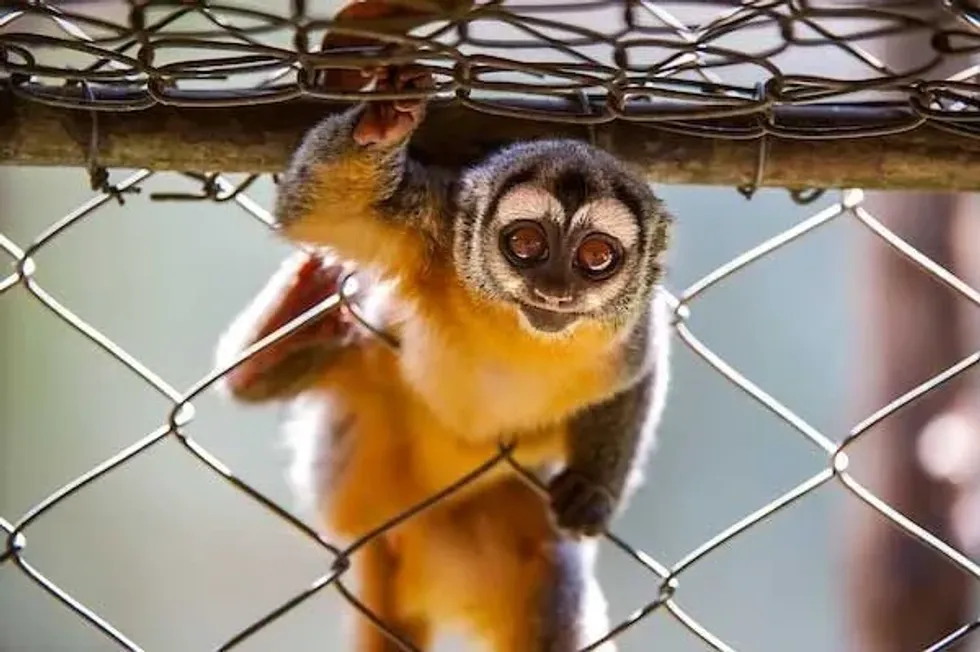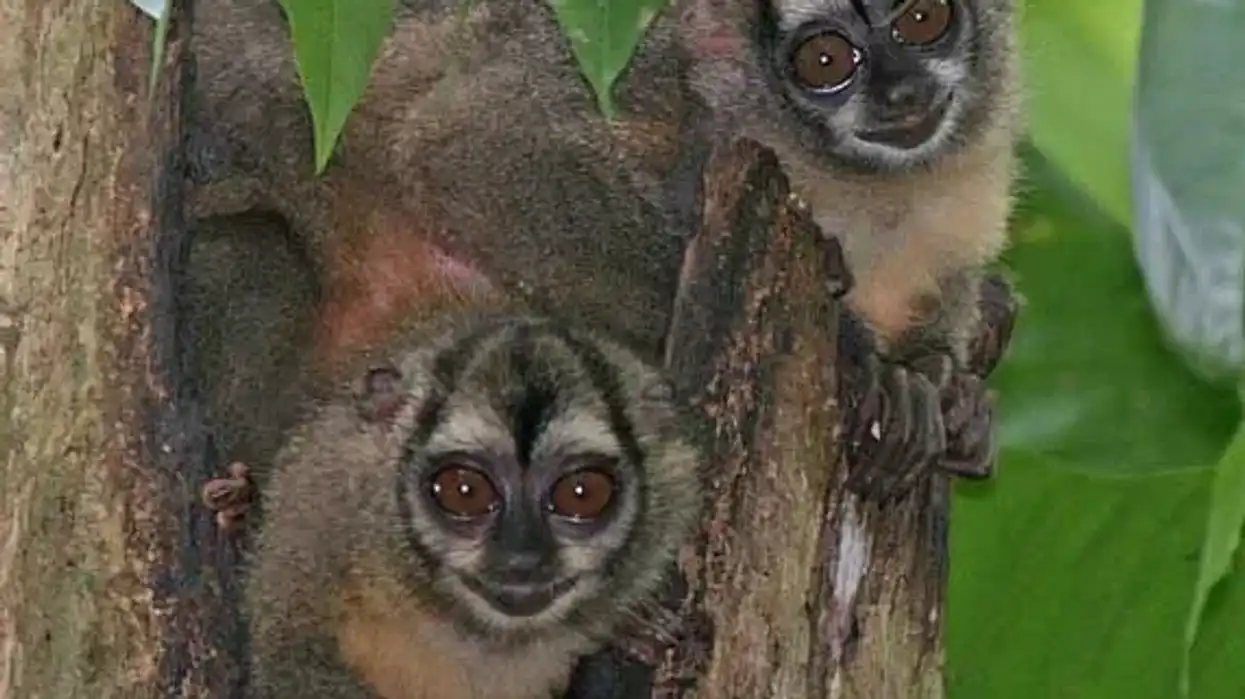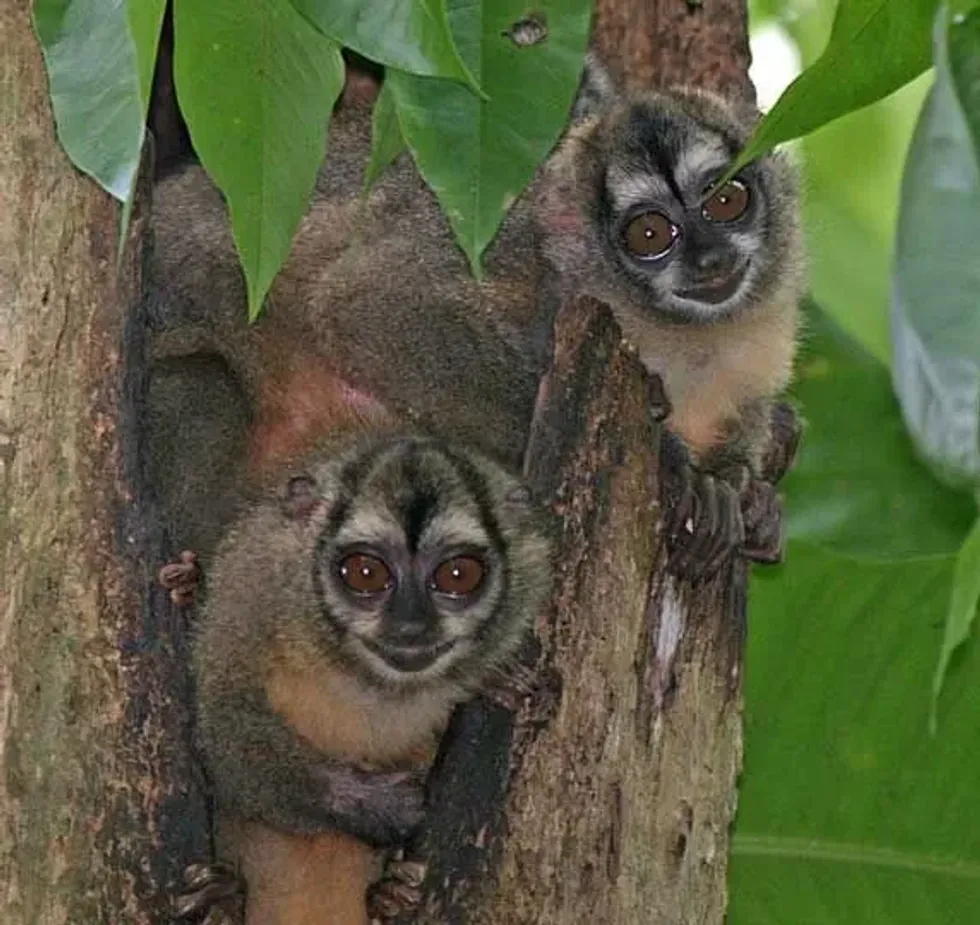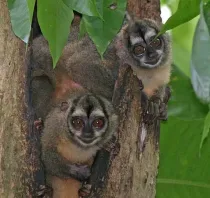Fun Night Monkey Facts For Kids

Found around the New World, the members of the genus Aotus are the only monkeys who are known to be active at night and sleep during the day, unlike most other types of monkeys. They are also called owl monkeys because of their small, round, owl-like faces.
They have large brown eyes that help to see better in the dark. Interestingly, these monkeys are monogamous.
The male members are known to initiate the mating process, and the reciprocal females are known to return their grooming.
They are very family-oriented, and both parents take an active part in raising the young. These monkeys are highly intelligent, and they have been known to produce at least 50 different types of calls, which is a very high range for any animal.
We have gathered a lot of interesting information about these animals in this article. Read on to learn more about these nifty little creatures.
If you like reading fun articles about monkeys, do check out the capuchin monkey and Colobus monkey.
Night Monkey Interesting Facts
What type of animal is a night monkey?
Night monkeys are a species of nocturnal monkeys native to the New World, like spider monkeys. These small monkeys are very social; in fact, individuals who have been kept alone in captivity were noticed to become highly uncomfortable in their surroundings until they were placed with another member of their own kind.
What class of animal does a night monkey belong to?
Like all primates, night monkeys are also mammals, which means that they give birth to live offspring rather than laying eggs. The genus name of the night monkey, Aotus, implies them to be 'earless,' which of course is not true.
However, their ears are quite well hidden and very hard to notice from a distance, hence earning them the name.
How many night monkeys are there in the world?
It is hard to say how many night monkeys are there in the world. However, the genus of the night monkey, Aotus, consists of about 11 species, who are native to the forests throughout the United States and much of South America.
One of them is considered an Endangered species in the IUCN Red List of Threatened Species. Four of them are considered Vulnerable, yet four others are listed as of Least Concern, and two of the primate species are Not Listed.
Where does a night monkey live?
These nocturnal owl monkeys are found throughout the forests of the United States and South America, namely, in Argentina, Paraguay, Ecuador, Panama, Guyana, Bolivia, Peru, and Brazil.
What is a night monkey's habitat?
As for their habitat, these primates prefer tropical rainforests as well as dry shrublands. Night monkeys are very fond of the trees, which is why they can be found around most levels of the forest but not really on the ground.
Who does night monkey live with?
These primates live in small family groups consisting of the adult pair and their offspring. Unlike other diurnal monkeys, the groups often spend the daylight hours sleeping upon the trees and active during the night. Both the males and the female members take an active part in raising their offspring.
How long does a night monkey live?
Like all members of the primate family, the night monkeys or owl monkeys have a long life span. On average, they can live up to 30-34 years.
Night monkeys are often described as sluggish creatures who do not stray very far from their habitat. In fact, the territory range of an individual group of the Owl monkey is quite short as well.
How do they reproduce?
The night monkeys are known to be monogamous, and they reach sexual maturity at about two and a half years. Males are known to initiate the mating process, and the reciprocating female is often observed to reciprocate by returning the grooming behavior.
The gestation period of the female lasts for about 133 days, after which one or even twins are born.
Both males and female members of the adult pair actively participate in raising the young, and they live as a family group until the young reach the age when they are fully independent and ready to start their own groups. Male night monkeys are known to be the more active parent and help in feeding, playing, and protection.
What is their conservation status?
There are a total of 11 species known as the night monkeys or owl monkeys that roam around the forests of the New World.
Their behavior all around is pretty similar, down to their habit of living in a small family group and their unwillingness to stray far from their habitat.
In the IUCN Red List of Threatened Species, four of the species like the Colombian night monkey are listed as a Vulnerable species, and four others, like the black-headed night monkey, are listed as a species of Least Concern.
At the same time, the conservation status of the Peruvian night monkey and three-striped night monkey, and some others are Not Listed in the IUCN Red List.
However, conservation groups are working very hard to protect this primate species.
The main reason for their decreasing numbers can be attributed to the destruction and urbanization of their natural habitat, which is forests with dense trees or shrublands.
Night Monkey Fun Facts
What does night monkey look like?

The night monkeys can be recognized by their round owl-like faces, which is why they are also called by the name of the owl monkey.
They have large eyes that are typically brown in color and round in shape. Their brown large eyes help them to see better in the dark as that is the time they are most active.
Most of the species of night monkeys look quite similar in their appearance, with a slight difference in their fur color here and there.
However, all of them are known to have short woolly fur that is often gray on their front side and buff or a reddish-brown on their back.
There are usually three brown or black stripes on their forehead region along the sides of their eyes and one on the middle of their eyebrows. Their ears are often almost invisible by their thick fur hence earning them the name of their genus, which means earless.
Behavior around all the members of this genus is also quite similar, down to their habit of living in small family groups and their unwillingness to stray far from their habitat.
How cute are they?
Night monkeys are cute creatures with small owl-like faces and their reddish-brown coloring. They have unique calls that help in communicating with members of their own kind.
How do they communicate?
Like all monkeys, the night monkeys are known to communicate through their unique calls and chemical trails. They are known to be able to use as many as 50 different types of calls depending on the situations they face. They have been known to use hisses, screeches, barks, or even owl-like hoots sometimes.
How big is a night monkey?
Night monkeys are small creatures, only growing up to about 9.4-14.5 in (24-36.8 cm). On average, their tail length is about 12.4-15.7 in (31.5-4o cm). Their length is similar to a macaque monkey, which is 16-28 in (41-70 cm) long.
How fast can a night monkey run?
It is hard to say just how fast night monkeys can run, but they are often described as slow-moving and sluggish, even to the point that they refuse to stray very far from their territory.
This behavior is true for all members of this genus, be it the Peruvian night monkey or the Colombian night monkey, so it can be assumed that they do not run very fast, choosing to rather hang around the tree branches and shrublands.
How much does a night monkey weigh?
Night monkeys are small creatures, and their weight is equally small. On average, they only weigh about 1-2.8 lb (455-1254 g).
What are the male and female names of the species?
Like all primates, the night monkeys do not have sex-specific terms. They are just known as male night monkeys and female night monkeys.
They are monogamous, with the males initiating the mating process and the females reciprocating. They reach sexual maturity at about two and a half years of age, and until then, they live in their small family group where they were born.
What would you call a baby night monkey?
The babies of night monkeys are just called offspring or young. The females give birth to one or two young after a gestation period of about 133 days, and they reach sexual maturity at about two and a half years of age.
The behavior around all the members of this genus is quite similar, and they live and hunt in a small family group in their small territory.
What do they eat?
Like all primates, the night monkeys are omnivores who are known to eat leaves, plant gums, invertebrates, fruits, insects, bark, flowers, and nuts alike. They tend to forage for food in large canopied trees in forests where fruits are more available, while these predators catch insects and bats from the air or from the tree branches.
As they are nocturnal predators, they hunt for food after the sunsets.
Are they poisonous?
Among all the species of the night monkey found across the world, none of them is poisonous. However, night monkeys may be confused with the Nycticebus kayan, which is a nocturnal primate and not a night monkey. The Nycticebus kayan is a poisonous animal.
Would they make a good pet?
Monkeys, in general, do not make good pets, and the night monkeys are no different. The main reason for that is they are intelligent wild creatures who are not meant to live a life in captivity.
As a result, they can become aggressive and become potentially harmful to you and your family.
They also have a long life, throughout which they will need a lot of space and constant regular care, which can cause the veterinarian bills can mount sky high. So, if you are not prepared to handle situations like this for the rest of your lives, maybe getting a night monkey as a pet is not a good idea.
Did you know...
Their tail is not really prehensile, which means that it does not really help to hang from tree branches but rather helping them with their general balance.
The large eyes of the night monkeys help forage for food among dense vegetation.
Which monkeys are nocturnal?
Night monkeys are the only monkeys that have been considered nocturnal. Among primates, tarsiers are also nocturnal.
Do they bite?
These monkeys are not really known for biting casually. They are more sluggish rather than friendly and rarely even get aggressive. However, in captivity, night monkeys placed with unfamiliar individuals have been known to get a little aggressive, with the males being more aggressive than the females.
Here at Kidadl, we have carefully created lots of interesting family-friendly animal facts for everyone to discover! Learn more about some other mammals from our vervet monkey facts and Bornean orangutan facts pages.
You can even occupy yourself at home by coloring in one of our free printable night monkey coloring pages.
We Want Your Photos!
More for You
See All
Bachelor of Arts specializing in Journalism and Mass Communication, Postgraduate Diploma in Sports Management

Moumita DuttaBachelor of Arts specializing in Journalism and Mass Communication, Postgraduate Diploma in Sports Management
A content writer and editor with a passion for sports, Moumita has honed her skills in producing compelling match reports and stories about sporting heroes. She holds a degree in Journalism and Mass Communication from the Indian Institute of Social Welfare and Business Management, Calcutta University, alongside a postgraduate diploma in Sports Management.
Bachelor of Arts specializing in English Literature, Masters of Art specializing in English and Communication Skills

Sonali RawatBachelor of Arts specializing in English Literature, Masters of Art specializing in English and Communication Skills
Sonali has a Bachelor's degree in English literature from Guru Gobind Singh Indraprastha University and is currently pursuing a Master's in English and Communication from Christ University. With considerable experience in writing about lifestyle topics, including travel and health, she has a passion for Japanese culture, especially fashion, and anime, and has written on the subject before. Sonali has event managed a creative-writing festival and coordinated a student magazine at her university. Her favorite authors are Toni Morrison and Anita Desai.
Disclaimer
1) Kidadl is independent and to make our service free to you the reader we are supported by advertising. We hope you love our recommendations for products and services! What we suggest is selected independently by the Kidadl team. If you purchase using the Buy Now button we may earn a small commission. This does not influence our choices. Prices are correct and items are available at the time the article was published but we cannot guarantee that on the time of reading. Please note that Kidadl is a participant in the Amazon Services LLC Associates Program, an affiliate advertising program designed to provide a means for sites to earn advertising fees by advertising and linking to Amazon. We also link to other websites, but are not responsible for their content.
2) At Kidadl, we strive to recommend the very best activities and events. We will always aim to give you accurate information at the date of publication - however, information does change, so it’s important you do your own research, double-check and make the decision that is right for your family. We recognise that not all activities and ideas are appropriate for all children and families or in all circumstances. Our recommended activities are based on age but these are a guide. We recommend that these ideas are used as inspiration, that ideas are undertaken with appropriate adult supervision, and that each adult uses their own discretion and knowledge of their children to consider the safety and suitability. Kidadl cannot accept liability for the execution of these ideas, and parental supervision is advised at all times, as safety is paramount. Anyone using the information provided by Kidadl does so at their own risk and we can not accept liability if things go wrong.
3) Because we are an educational resource, we have quotes and facts about a range of historical and modern figures. We do not endorse the actions of or rhetoric of all the people included in these collections, but we think they are important for growing minds to learn about under the guidance of parents or guardians.







